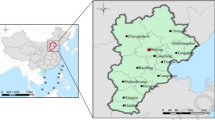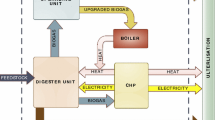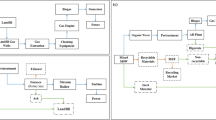Abstract
Waste-to-energy is one effective waste management approach for a sustainable society. The purpose of this study was to clarify the potential for energy recovery and greenhouse gas (GHG) reduction that could be achieved by introducing anaerobic digestion (AD) facilities in the process of reconstructing aging incineration facilities in Japan. Using statistical data from 1068 incineration facilities, four future scenarios were considered and compared with the current situation. As results, compared with the current situation the amount of electricity generated could increase by 60 % in 2030, by combining AD facilities for food waste with new, high-efficiency incineration facilities for remaining municipal solid waste (MSW). From a life cycle perspective, net energy recovery in 2030 was approximately three times greater than in 2011, and GHG emission could be reduced by 27 %. The introduction of AD facilities is attractive for small authorities, which currently treat <100 t/day of MSW through incineration facilities without energy recovery. An AD facility is also beneficial for large authorities. On the contrary, in middle-scale authorities that treat 100–299 t/day of MSW, the reconstruction of incineration facilities to include electricity production capabilities requires careful consideration, because it will significantly influence energy recovery and GHG reduction effects.




Similar content being viewed by others
References
European Union (2015) Sustainable development in the European Union. 2015 monitoring report of the EU sustainable development strategy
Ministry of the Environment (MOE), Japan (2016) Annual report on the Environment, the Sound Material-Cycle Society and Biodiversity in Japan. http://www.env.go.jp/policy/hakusyo/h28/pdf.html. Access Jun 2016 (in Japanese)
MOE, Japan (2013) Results of factual investigation of domestic waste disposal as of FY2011. http://www.env.go.jp/recycle/waste_tech/ippan/. Accessed Dec 2015 (in Japanese)
Food and Agriculture Organization of the United Nations (FAO) (2011) Global food losses and food waste. FAO, Rome
Monier V, Mudgal S, Escalon V, O’Connor C, Anderson G, Reisinger H, Dolley P, Ogilvie S, Morton G.G (2010) Preparatory study on food waste across EU27. Final report. European Commission (DG ENV) Directorate C-Industry (Ed), Contract #: 07.0307/2009/540024/SER/G4
IGES (2011) Practical Guide for improved organic waste management: climate benefits through the 3Rs in developing Asian countries. IGES Policy Report. IGES, Kanagawa. ISBN 978-4-88788-077-1
MAFF and MOE, Japan (2013) Progress of Food Recycling Law in Japan. Document 2, 1st joint meeting of Central Environment Council of recycling society sectional meeting of advisory committee of food recycling and Council of Food, Agriculture and Rural Area Policies of food industrial sectional meeting of subcommittee of food recycling. https://www.env.go.jp/council/03recycle/y031-01/mat02-1.pdf. Accessed Dec 2015 (in Japanese)
MAFF and MOE, Japan (2013) Law for promotion of recycling and related activities for the treatment of cyclical food cyclical resources. http://law.e-gov.go.jp/htmldata/H12/H12HO116.html. Accessed Dec 2015 (in Japanese)
Eriksson O, Reich MC, Frostell B, Björklund A, Assefa G, Sundqvist J-O, Granath J, Baky A, Thyselius L (2005) Municipal solid waste management from a system perspective. J Clean Prod 13:241–252
Bernstad A, Jansen J, La C (2011) A life cycle approach to the management of household food waste: a Swedish full-scale case study. Waste Manag 31(8):1879–1896
Kirkeby JT, Birgisdottir H, Hansen TL, Christensen TH (2006) Evaluation of environmental impacts from municipal solid waste management in the municipality of Aarhus, Denmark (EASEWASTE). Waste Manag Res 24(1):16–26
Turconi R, Butera S, Boldrin A, Grosso M, Rigamonti L, Astrup T (2011) Life cycle assessment of waste incineration in Denmark and Italy using two LCA models. Waste Manag Res 29(10):78–90
Fruergaard T, Astrup T (2011) Optimal utilization of waste-to-energy in an LCA perspective. Waste Manag 31(3):572–582
Cherubini F, Bargigli S, Ulgiati S (2008) Life cycle assessment of urban waste management: energy performance and environmental impacts. The case of Rome, Italy. Waste Manag 28(12):2552–2564
Cherubini F, Bargigli S, Ulgiati S (2009) Life cycle assessment (LCA) of waste management strategies: landfilling, sorting and incineration. Energy 34(12):2116–2123
Grosso M, Nava C, Testori R, Rigamonti L, Viganò F (2012) The implementation of anaerobic digestion of food waste in a highly populated urban area: an LCA evaluation. Waste Manag Res 30(9):78–87
Evangelisti S, Lettieri P, Borello D, Clift R (2014) Life cycle assessment of energy from waste via anaerobic digestion: a UK case study. Waste Manag 34(1):226–237
Koroneos CJ, Nanaki EA (2012) Integrated solid waste management and energy production—a life cycle assessment approach: the case study of the city of Thessaloniki. J Clean Prod 27:141–150
Güereca LP, Gassó S, Baldasano JM, Jiménez-Guerrero P (2006) Life cycle assessment of two biowaste management systems for Barcelona, Spain. Resour Conserv Recycl 49(1):32–48
Kim MH, Song HB, Song Y, Jeong IT, Kim JW (2013) Evaluation of food waste disposal options in terms of global warming and energy recovery: Korea. Int J Energy Environ Eng 4(1):1–12
Bastian L, Yano J, Hirai Y, Sakai S (2013) Greenhouse gas emissions from biogenic waste treatment: options and uncertainty. J Mater Cycles Waste Manag 15(1):49–60
Sakai S, Hirai Y, Yoshikawa K, Deguchi S (2005) Distribution of potential biomass/waste resources and GHG emission analysis for food waste recycling system. J Jpn Soc Waste Manag Experts 16(2):173–187 (in Japanese)
Takaoka M, Masuda T (2010) Intermediate treatment of municipal solid waste in relation to a sound material cycle and low-carbon society. Mater Cycles Waste Manag Res 21(6):368–379 (in Japanese)
Sakai S, Yano J (2013) Outlook for municipal solid waste management strategies for promoting reduction and recycling of food waste. Mater Cycles Waste Manag Res 25(1):55–68 (in Japanese)
Bernstad A, Jansen J, La C (2012) Review of comparative LCAs of food waste management systems: current status and potential improvement. Waste Manag 32(12):2439–2455
Morris J, Matthews HS, Morawski C (2013) Review and meta-analysis of 82 studies on end-of-life management methods for source separated organics. Waste Manag 33(3):545–551
Møller J, Boldrin A, Christensen TH (2009) Anaerobic digestion and digestate use: accounting of greenhouse gas and global warming contribution. Waste Manag Res 27(8):813–824
IPCC (2006) Guideline for national greenhouse gas inventories, prepared by National Greenhouse Gas Inventories Programme. In: Eggleston HS, Buendia L, Miwa K, Ngara T, Tanabe K (eds) IGES, Japan
Clavreul J, Guyonnet D, Christensen TH (2012) Quantifying uncertainty in LCA-modelling of waste management systems. Waste Manag Res 32(12):2482–2495
Liu J, Paode RD, Holsen TM (1996) Modeling the energy content of municipal solid waste using multiple regression analysis. J Air Waste Manag 46:650–656
NIPSSR (National institute of population and social security research) (2012) Population projection for Japan: 2011 to 2060. http://www.ipss.go.jp/site-ad/index_english/esuikei/gh2401e.asp. Accessed Dec 2015
Reimann DO, Scientific & Technical Advisor to CEWEP (2012) CEWEP energy report III (Status 2007–2010). CEWEP, Bamberg
MOE, Japan (2013) Maintenance plan for waste treatment facilities during 2013–2017 (in Japanese)
IPCC (2007) Climate change 2007 (AR4), Working group I report. The physical science basis
Ishikawa M (1996) A logistics model for post-consumer waste recycling. J Packag Sci Technol Jpn 5(2):119–130
NIES (2008) Technical development report of hydrogen production from biomass and biowaste. Tsukuba, Japan (in Japanese)
Yasuda K (1997) Greenhouse gas emissions from waste incineration in Japan. J Jpn Soc Waste Manag Experts 8(6):432–437 (in Japanese)
MOE, Japan (2009) Guideline for the estimation and its report on greenhouse gas emission Ver 2.4 (in Japanese)
ASTEM (2010) Production of green methanol for carbon-free BDF and development of efficient conversion technologies from by-product materials. (in Japanese)
MOE, GIO, CGER, NIES (2014) National greenhouse gas inventory report of Japan. http://www-gio.nies.go.jp/aboutghg/nir/nir-j.html. Access Dec 2015
Dote Y, Kurata Y, Maruyama T (1999) CO2 discharge by operation of non-industrial waste disposal site. In: Proceedings of the annual conference of the Japan Society of Waste Management Experts (in Japanese)
The Federation of Electric Power Companies of Japan (FEPCJ) (2013) Environmental action plan of electric utility (in Japanese)
Toyota Motor Corporation, Mizuho Information & Research Institutem, Inc. (2004) Well-to-wheel analysis of greenhouse gas emissions of automotive fuels in the Japanese context-well-to-tank Report
World Energy Council (WEC) (2010) 2010 survey of energy resources. WEC, London
Huijbregts MAJ (1998) Application of uncertainty and variability in LCA, a general framework for the analysis of uncertainty and variability in life cycle assessment. Int J Life Cycle Assess 3(5):273–280
Börjesson P, Berglund M (2007) Environmental systems analysis of biogas systems: Part II: the environmental impact of replacing various reference systems. Biomass Bioenergy 31(5):326–344
Heijungs R, Kleijn R (2001) Numerical approaches towards life cycle interpretation—five examples. Int J Life Cycle Assess 6(3):141–148
Reisinger H, van Acoleyen M, O’Connor C, Hestin M, Laureysens L, Morton G, Dolley P, Nelen D, Vanderreydt I (2011) Evolution of (bio-) waste generation/prevention and (bio-) waste prevention indicators Final Report, A project under the Framework contract ENV. G. 4/FRA/2008/0112
Watson D, Milios L, Bakas I, Herczeg M, Kjær B, Tojo N (2013) Proposals for targets and indicators for waste prevention in four waste streams. Nordic Council of Ministers, Copenhagen
Brunner PH, Rechberger H (2015) Waste to energy: key element for sustainable waste management. Waste Manag 37:3–12
Author information
Authors and Affiliations
Corresponding author
Electronic supplementary material
Below is the link to the electronic supplementary material.
Rights and permissions
About this article
Cite this article
Yano, J., Sakai, Si. Energy recovery and greenhouse gas reduction potential from food waste in Japan. J Mater Cycles Waste Manag 18, 631–645 (2016). https://doi.org/10.1007/s10163-016-0531-y
Received:
Accepted:
Published:
Issue Date:
DOI: https://doi.org/10.1007/s10163-016-0531-y




